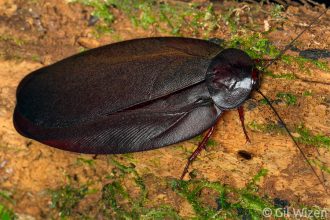Do You Know Cockroaches? (AKA: Nerding out)
- Chelle Hartzer

- Apr 20, 2021
- 3 min read
My sister asked me for some “fun” cockroach facts for a presentation she needed to do. Of course, I went into full nerd mode and started searching papers for interesting info on these incredible insects! There is so much and I just have to share. You’re welcome:
There are a lot of cockroach species. In the US, our main pest species of cockroach are the German, American, Oriental, and brown banded. However, there are more than 70 species native to North America and nearly 5,000 species world wide. Compare that to mammals: 6,399 current species.
Many cockroach species can tolerate low temperatures. The Oriental cockroach (B. orientalis) can survive at -10oC (14oF). American cockroaches (P. americana) are less hardy and can’t survive below 10oC (50oF).
Cockroaches can carry a lot of microorganisms. Studies from hospitals showed German cockroaches (B. germanica) had Enterobacteriaceae and Staphylococcus as was well as a number of fungi. They have been implicated in the spread of dysentery, hepatitis, and antibiotic resistant bacteria. They can also spread E. coli and Salmonella. These can be spread by the cockroaches picking up contaminated bits of food or through their droppings in some cases.
Their closest relatives are the termites. In fact, a recent revision of the scientific tree put cockroaches and termites in the same order (they used to be separate orders). There are a lot of cockroaches that are found in wood, mostly decomposing wood. And while they are not truly social (no communal care of the young), they are often found in large groups, almost colonies.
Cockroaches are hard to manage. When looking at the genome of the American cockroach, researchers found they have a massive genome and many genes that help them survive urban environments. They have tons of chemical receptors, olfactory receptors, gustatory receptors, and codes for many enzymes that allow them to resist pesticides and survive extremes in the environment.
Cockroaches can survive radiation… but not a nuclear bomb. Testing showed American cockroaches died at doses of 20,000 rads but would suffer reproductive losses starting at 1,000. Humans will die at 1,000 rads so cockroaches will definitely outlive us. However other insects are much more resistant to radiation. The humble fruit fly survived up to 64,000 rads.
Cockroaches are old… but not that old! The oldest fossil of a cockroach is from sometime between 125-140 million years ago. Compare that to dragonflies that first appeared around 350 million years ago and a recently found millipede fossil that was from 425 million years ago.
There are many quite beautiful species of cockroaches. Yes, beauty is in the eye of the beholder, but you can’t tell me some of these color patterns are not pretty! Even better: there is a species of glow-in-the-dark cockroach.
All that time to evolve has allowed them to adapt to getting into really tight spaces. Cockroaches can flatten their bodies to squeeze through tiny openings. The 9 millimeter high American cockroach can get through spaces just 3 millimeters high in under a second.
Smallest cockroach: the ant cockroach (Attaphila fungicola)
Largest cockroach: a tie between the rhinoceros cockroach (Macropanesthia rhinoceros) and Megaloblatta longipennis.
All of this diversity, evolution, and behavioral tactics they have gained makes our pest species difficult to control. With the right knowledge and experience, it can be done so give us a contact to see how we can help you solve cockroach (and other pests) issues faster and prevent them from happening in the future.
And comment below with your best cockroach fun fact!


























Here are 2 facts about an interesting species. Diploptera punctata or the Pacific beetle cockroach is one of the few species of cockroach that is viviparous and produces a nutritionally dense crystalline "milk" to feed their live-born young. Adults have a chemical defense comprised of a modified tracheal gland and spiracle on each side of the body which squirts quinones that can poison or discourage a predator.